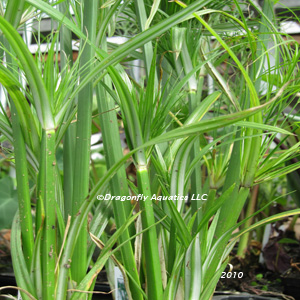 One of our most popular bog plants is the Dwarf Papyrus. I think its an unusual looking plant and adds alot of dimension to the pond. It always seems to grow well and is one pond plant that is easy to grow and attend to. The Dwarf Papyrus is a good bog plant to create a tub garden or tabletop pond. I have one growing in a ceramic pot on my patio and it does well.
One of our most popular bog plants is the Dwarf Papyrus. I think its an unusual looking plant and adds alot of dimension to the pond. It always seems to grow well and is one pond plant that is easy to grow and attend to. The Dwarf Papyrus is a good bog plant to create a tub garden or tabletop pond. I have one growing in a ceramic pot on my patio and it does well.
The papyrus grows in sun to part shade and likes moist soil and can tolerate water up to 4 inches deep. Its considered hardy Zones 8-11 but can easily be wintered over indoors. As long as you keep the plant in 50 degrees and above it will be fine. You may watch for mealybugs as they will sometimes appear on the plant during the winter but can easily be treated.
They grow 12-18 inches high with a spread of 6-12 inches. To start other plants take the seeds and put in wet soil or propagate from the viviparous top fronds. You'll soon have other plants to place in your pond.
If you like larger plants you can go for the Dwarf Giant Papyrus (Cyperus percamenthus) which will grow about 3 feet high. There is also the Egyptian Papyrus (Cyperus papyrus) which can grow to 8 feet high.
Whichever Papyrus you chose it is a unique pond plant for your pond.
There are iris of almost any color one would want.....of course I want to plant them all around the pond. Although they only bloom once during the season I anxiously await their blooms. The Colorific is exactly like its name...blending of colors and quite unique. This plant only had about three flowers on it this year since it was just planted but next year will have more.
Then there is the Clyde Redmond which blooms a little later in the season. Its nice to have different iris blooming at different times of the season. The Wedgwood blue color of this iris adds alot to the pond.
Other than dividing the iris in the early spring they require little care and the rewards of color in your pond are worth it.
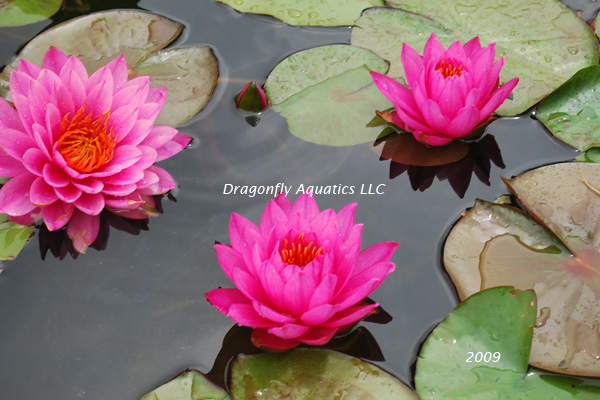 As the weather warms up and we begin to assess what plants we want to add to our ponds this spring, make sure you check out your hardy water lilies to see if they are in need of re-potting. Adding Highland Rim Fertilizer tablets at this time is also a must do. Water lilies need to be fertilized every 4-6 weeks to ensure plenty of flowers this summer.
As the weather warms up and we begin to assess what plants we want to add to our ponds this spring, make sure you check out your hardy water lilies to see if they are in need of re-potting. Adding Highland Rim Fertilizer tablets at this time is also a must do. Water lilies need to be fertilized every 4-6 weeks to ensure plenty of flowers this summer.
Dividing the water lilies and re-potting them in early spring will ensure a better performing water lily this summer. Several lilies in the same pot compete for available nutrients resulting in fewer flowers this summer.
Water lilies need to be planted in at least a 1 gallon planting container for best performance. The medium to large varieties should be potted in a 2 to 5 gallon planting container to reach maximum flowering and growing potential. Don't be fooled by purchasing a potted lily in a 4 inch pot and expect it to flourish in your pond. You will end up paying more for the lily, and will still need to purchase a larger container to re-pot the lily in.
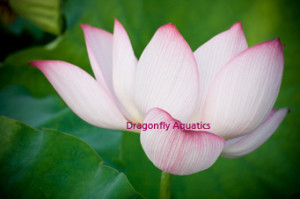 Those who have lotus are now enjoying the sun loving water plant that thrives in hot weather and high humidity.
Those who have lotus are now enjoying the sun loving water plant that thrives in hot weather and high humidity.
The unique lotuses are hardy water plants that can be wintered over even in the coldest of climates. Caring for your lotus as the season comes to an end is important. You want to cut back the foliage to the water surface after the leaves have all died and turned brown. If you cut them back while they are still green, bacteria or fungal infections can reach the underground tuber and can kill the plant.
The care given to the lotus is much similiar to the care of your hardy water lilies, keeping the tubers deep enough in the pond that the ice and frost will not reach them. It is easier to accomplish this with lotus in a shallow pond than it is with hardy water lilies. The lotus roots grow at the bottom of the pot, while your water lilies rhizomes are often at the soil surface.
If you choose not to overwinter your lotus in your pond you can put the pot in a trash bag and store it where it will stay cool, dark and damp. Making sure it doesn't freeze.
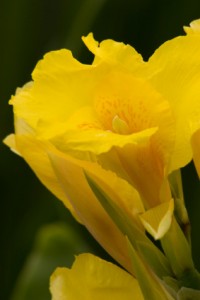 The striped beauty canna has flowers that are white and yellow petals with red stems. Its leaves are a bright green striped in white. It will reach 3-5 feet high and grow 3-4 feet wide. Best if grown in water that is up to 1 inch deep. Hardy in Zones 8 - 11. They cannot withstand a winter freeze. You can bring them indoors for the winter or you can let them dry out so the tubers can be cleaned and stored for the winter. It has been successful taking cannas and placing them in the bottom of your pond for the winter. As long as the rhizomes are not reached by ice during the winter they will return in the spring.
The striped beauty canna has flowers that are white and yellow petals with red stems. Its leaves are a bright green striped in white. It will reach 3-5 feet high and grow 3-4 feet wide. Best if grown in water that is up to 1 inch deep. Hardy in Zones 8 - 11. They cannot withstand a winter freeze. You can bring them indoors for the winter or you can let them dry out so the tubers can be cleaned and stored for the winter. It has been successful taking cannas and placing them in the bottom of your pond for the winter. As long as the rhizomes are not reached by ice during the winter they will return in the spring.
Striped Beauty Canna can be found here.
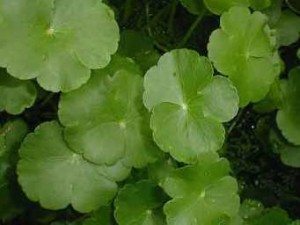 This plant is an excellent water plant for stream beds, bogs or edges of your pond. It grows to about 6"-12" high out of the water and is a fast grower. It leaves are usually shiny and can be anywheres from 3 inches to only 1/2 inch in diameter. This plant is useful in the water garden because of its quick ability to create shade over the pond and grows running stems that will float out over the water surface. It creates a soft edge between water and taller plants such as the cattails, iris or sweet flags.
This plant is an excellent water plant for stream beds, bogs or edges of your pond. It grows to about 6"-12" high out of the water and is a fast grower. It leaves are usually shiny and can be anywheres from 3 inches to only 1/2 inch in diameter. This plant is useful in the water garden because of its quick ability to create shade over the pond and grows running stems that will float out over the water surface. It creates a soft edge between water and taller plants such as the cattails, iris or sweet flags.
It will grow well in sun to part shade and is hardy in Zones 5-11. It grows best in moist soil to water no more than 4 inches deep.
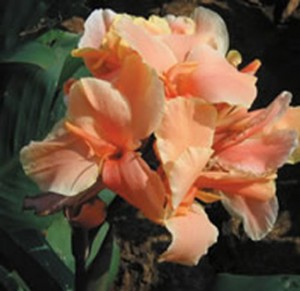 Tropical Sunrise Canna is one of the showiest cannas I've seen. New this year for us it produces large apricot and pink blooms. It has deep green foliage and grows to about 3 feet tall. It is an early bloomer and will continue to bloom throughout the season. Cannas are considered tropical and need to be dug up in late fall after the first frost in northern climates. You can store the tubers in lightly moistened peat and replant the following season.
Tropical Sunrise Canna is one of the showiest cannas I've seen. New this year for us it produces large apricot and pink blooms. It has deep green foliage and grows to about 3 feet tall. It is an early bloomer and will continue to bloom throughout the season. Cannas are considered tropical and need to be dug up in late fall after the first frost in northern climates. You can store the tubers in lightly moistened peat and replant the following season.
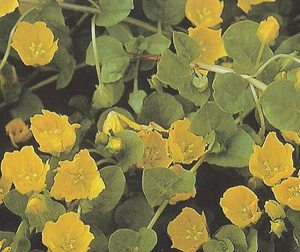 Creeping jenny is an excellent cover for edges of water gardens or waterfalls. It grows to about 1-2 inches and creeps in the moist soil or water to 1 inch deep. Its rounded leaves will clasp onto other leaves and form a tight clump of foliage with yellow, buttercup-like flowers appearing throughout the summer. It will grow in sun or shade. You can take short stem cuttings of this plant and begin new ones in a mixture of equal parts peat and perlite.
Creeping jenny is an excellent cover for edges of water gardens or waterfalls. It grows to about 1-2 inches and creeps in the moist soil or water to 1 inch deep. Its rounded leaves will clasp onto other leaves and form a tight clump of foliage with yellow, buttercup-like flowers appearing throughout the summer. It will grow in sun or shade. You can take short stem cuttings of this plant and begin new ones in a mixture of equal parts peat and perlite.
I always have this plant in several areas of my pond covering rock edges, waterfalls and areas in my bog that I like to hide. Its an easy plant to grow and is enjoyed by its bright yellow flowers and attractive foliage.